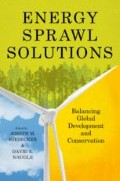Abstract
In part I of this book, we provided an overview of the challenges for meeting future energy demand, demonstrating that regardless of the future energy mix, energy sprawl will be significant and likely lead to land-use conflict. In part II we highlighted best-practice options for reducing this conflict, offering innovative solutions to improve the future energy footprint. Now in this chapter we turn our attention to steps that establish those best practices as common practice for achieving sustainable energy landscapes that meet energy, economic, social, and environmental goals.
Notes
- 1.
Gavin Bridge, Stefan Bouzarovski, Michael Bradshaw, Nick Eyre, “Geographies of Energy Transition: Space, Place and the Low-Carbon Economy,” Energy Policy 53 (2013): 331–40, doi:10.1016/j.enpol.2012.10.066.
- 2.
Anis Radzi and Peter Droege, “Latest Perspectives on Global Renewable Energy Policies,” Current Sustainable/Renewable Energy Reports 1, no. 3 (2014): 85–93, doi:10.1007/s40518-014-0014-5.
- 3.
John Colton, Kenneth Corscadden, Stewart Fast, Monica Gattinger, Joel Gehman, Martha Hall Findlay, Dylan Morgan, Judith Sayers, Jennifer Winter, and Adonis Yatchew, “Energy Projects, Social Licence, Public Acceptance and Regulatory Systems in Canada: A White Paper,” SSRN Journal (June 2016), doi:10.2139/ssrn.2788022.
- 4.
Aaron Bielenberg, Mike Kerlin, Jeremy Oppenheim, and Melissa Roberts, “Financing Change: How to Mobilize Private-Sector Financing for Sustainable Infrastructure” (McKinsey Center for Business and Environment, January 2016), http://2015.newclimateeconomy.report/wp-content/uploads/2016/01/Financing_change_How_to_mobilize_private-sector_financing_for_sustainable-_infrastructure.pdf.
- 5.
Helen Moser and Erin Nealer, “Barriers to Bankable Infrastructure” (Center for Strategic and International Studies, April 2016), https://csis-prod.s3.amazonaws.com/s3fs-public/publication/160308_Moser_BarriersBankableInfrastructure_Web.pdf.
- 6.
Organisation for Economic Co-operation and Development, “Mapping Channels to Mobilise Institutional Investment in Sustainable Energy,” 2015, doi:10.1787/978926 4224582-en.
- 7.
IEA, World Energy Outlook 2015 (see ch. 1, n. 3).
- 8.
Vaclav Smil, “Global Energy: The Latest Infatuations,” American Scientist 99, no. 3 (2011): 212–19, doi:10.1511/2011.90.212.
- 9.
Paul Collier and Anthony Venables, “Greening Africa? Technologies, Endowments and the Latecomer Effect,” Energy Economics 34, supplement 1 (2012): S75–84, doi:10.1016/j.eneco.2012.08.035.
- 10.
IEA, World Energy Outlook 2015 (see ch. 1, n. 3).
- 11.
Amar Bhattacharya, Jeremy Oppenheim, and Lord Nicholas Stern, “Driving Sustainable Development through Better Infrastructure: Key Elements of a Transformation Program,” Brookings Global Economy and Development Working Paper no. 91, 2015; N. Stern and P. Calderon, “Better Growth, Better Climate: The New Climate Economy Report” (Global Commission on the Economy and Climate, 2014).
- 12.
Food and Agriculture Organization of the United Nations, The Agriculture Sectors in the Intended Nationally Determined Contributions: Analysis, June 2016.
- 13.
Gavin Shaw, Jillian Kenny, Arun Kumar, and David Hood, “Sustainable Infrastructure Operations: A Review of Assessment Schemes and Decision Support,” in conference proceedings from 25th ARRB Conference, 2012.
- 14.
Office of NEPA Policy and Compliance, Final Programmatic Environmental Impact Statement (PEIS) for Solar Energy Development in Six Southwestern States, FES 12-24; DOE/EIS-0403 (Washington, DC: US Bureau of Land Management/US Department of Energy: 2012).
- 15.
Rajesh Singh, H. R. Murty, S. K. Gupta, and A. K. Dikshit, “An Overview of Sustainability Assessment Methodologies,” Ecological Indicators 15, no. 1 (2012): 281–99, doi:10.1016/j.ecolind.2011.01.007.
- 16.
Heiner et al., “Identifying Conservation Priorities” (see ch. 6, n. 8).
- 17.
Bielenberg et al., “Financing Change”; Bhattacharya et al., “Driving Sustainable Development.”
- 18.
Bhattacharya et al., “Driving Sustainable Development”; Joerg Hartmann, David Harrison, Jeff Opperman, and Roger Gill, Jonathan Higgins, Amy Newsock, Randy Curtis, Denny Grossman, Paulo Petry, Rosario Gomez, Juliana Delgado, Tomas Walschburger, Jose Yunis, Juan Carlos Gonzalez, Ana Cristina Barros, and Nelida Barajas, “The New Frontier of Hydropower Sustainability: Planning at the System Scale” (The Nature Conservancy, 2013); Heiner et al., “Identifying Conservation Priorities”; Cesar Poveda and Michael Lipsett, “A Review of Sustainability Assessment and Sustainability/Environmental Rating Systems and Credit Weighting Tools,” Journal of Sustainable Development 4, no. 6 (2011), doi:10.5539/jsd.v4n6p36; Jianguo Wu and Tong Wu, “Sustainability Indicators and Indices: An Overview. In Handbook of Sustainable Management, edited by Christian Madu and Chu-Hua Kuei (London: Imperial College Press, 2012); International Finance Corporation, IFC Performance Standards on Environmental and Society Sustainability, 2012, http://www.ifc.org/wps/wcm/connect/c8f524004a73daeca09afdf998895a12/IFC_Performance_Standards.pdf?MOD=AJPERES.
- 19.
Spiro Pollalis, Andreas Georgoulias, Stephen Ramos, and Daniel Schodek, eds., Infrastructure Sustainability and Design (New York: Routledge, 2012); Georgoulias Andreas, Jill Allen, Libby Farley, Jon Kao, and Irina Mladenova, “Towards the Development of a Rating System for Sustainable Infrastructure: A Checklist or a Decision-Making Tool?” from Proceedings of the Water Environment Federation, Cities of the Future/Urban River Restoration 13 (2010): 379–91, doi:10.2175/193864710798284643.
- 20.
Adam Smith International, “Integrated Resource Corridors Initiative: Scoping and Business Plan,” 2015.
- 21.
Carlos Pascual and Jason Bordoff, “A Global Low-Carbon Challenge,” Democracy: A Journal of Ideas (Winter 2016), no. 39, http://democracyjournal.org/magazine/39/a-global-low -carbon-challenge/.
Editor information
Editors and Affiliations
Rights and permissions
Copyright information
© 2017 The Nature Conservancy
About this chapter
Cite this chapter
Krueger, L., McKenney, B., Watkins, G., Amin, AL. (2017). Policies, Practices, and Pathways for Sustainable Energy. In: Kiesecker, J.M., Naugle, D.E. (eds) Energy Sprawl Solutions. Island Press, Washington, DC. https://doi.org/10.5822/978-1-61091-723-0_10
Download citation
DOI: https://doi.org/10.5822/978-1-61091-723-0_10
Publisher Name: Island Press, Washington, DC
Print ISBN: 978-1-61091-867-1
Online ISBN: 978-1-61091-723-0
eBook Packages: Earth and Environmental ScienceEarth and Environmental Science (R0)

